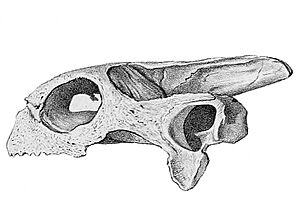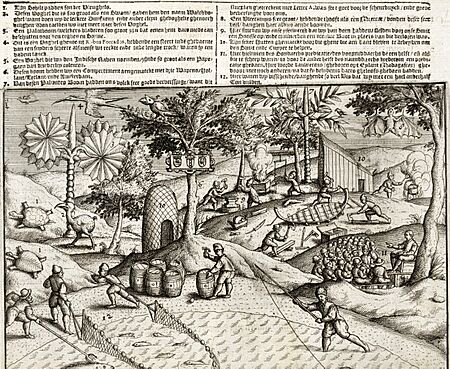Saddle-backed Mauritius giant tortoise facts for kids
Quick facts for kids Saddle-backed Mauritius giant tortoise |
|
|---|---|
 |
|
| Skull of Cylindraspis inepta | |
| Conservation status | |
| Scientific classification | |
| Genus: |
Cylindraspis
|
| Species: |
inepta
|
| Synonyms | |
|
|
The saddle-backed Mauritius giant tortoise (scientific name: Cylindraspis inepta) was a huge tortoise that used to live on the island of Mauritius. It was a special type of giant tortoise found only there. Sadly, this amazing creature is now extinct. The last time anyone saw one was in the early 1700s.
What Did It Look Like?
Mauritius was home to two different kinds of giant tortoises. This one, the saddle-backed species, had a unique shell shape. Its shell was raised at the front, like a saddle. This shape helped it reach higher leaves and branches to eat.
The other type of tortoise on Mauritius had a flatter shell. That one ate grass and leaves that had fallen on the ground. Even though both types were big, their bodies and bones were quite different.
Scientists believe this saddle-backed tortoise was the ancestor of four other giant tortoise species. These other species lived on nearby islands like Reunion and Rodrigues. It's thought that some of these tortoises might have floated to these islands by accident. Its scientific name, "inepta", means "clumsy." This name came from the idea that it might have often fallen into the ocean.
Why Did It Disappear?
The saddle-backed Mauritius giant tortoise used to be very common. It lived all over the main island of Mauritius and on smaller islands nearby. But Mauritius was one of the first islands in its area to be settled by people. This led to many native animals, including these tortoises, disappearing.
These giant tortoises were known to be friendly and curious. They were not afraid of humans, which made them easy targets. When Dutch settlers arrived, many tortoises were killed. They were hunted for food or for their fat and oil.
New animals also arrived with the settlers. Rats, cats, and pigs were brought to the island. These animals ate the tortoise eggs and their young babies. This made it very hard for new tortoises to survive.
The saddle-backed tortoise likely disappeared from the main island of Mauritius around the year 1700. By 1735, they were probably gone from most of the smaller islands too.
Last Refuge on Round Island
Some people thought that at least one type of Mauritius giant tortoise might have lived longer on Round Island. This small island is just north of Mauritius. A report from 1846 mentioned tortoises still being there.
In 1844, an expedition found some very large tortoises on Round Island. But by then, the island was full of many rabbits that had been brought there.
Later, in 1870, the Governor of Mauritius, Sir Henry Barkly, was worried about animals disappearing. He heard about the 1844 trip from one of the explorers, Mr. William Kerr. Mr. Kerr said that another explorer, Mr. Corby, had found a female tortoise in a cave on Round Island. She was brought to Mauritius and had many babies. These baby tortoises were given to different people.
The Governor tried to find these baby tortoises but could not. Even though a tortoise born in 1845 could have lived for a very long time, no one knows what happened to them.
Round Island itself was already damaged by the rabbits. Then, goats were also brought to the island. These new animals, or other problems, caused the last tortoises on Round Island to die out. When the last of Corby's baby tortoises died, the entire species was gone forever.




